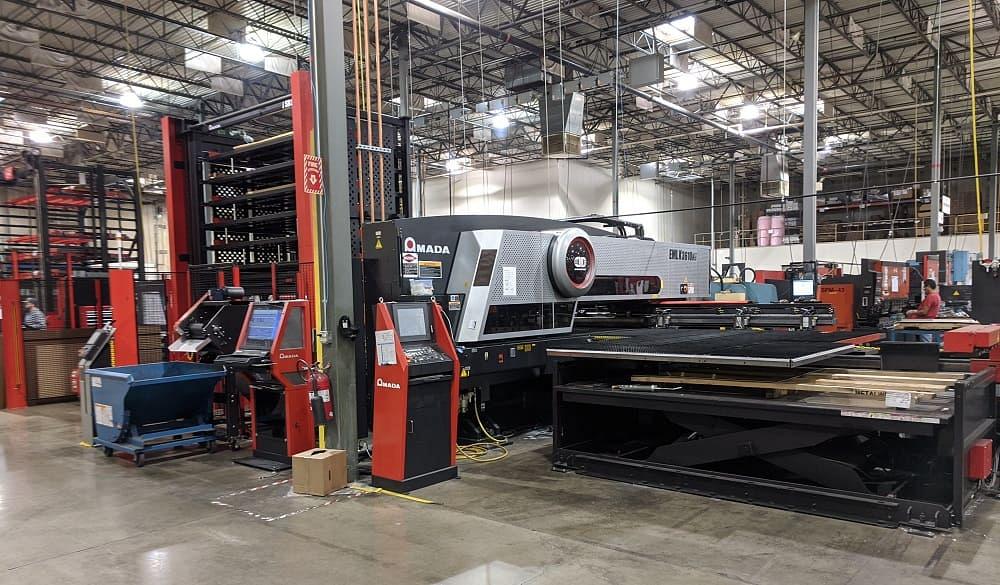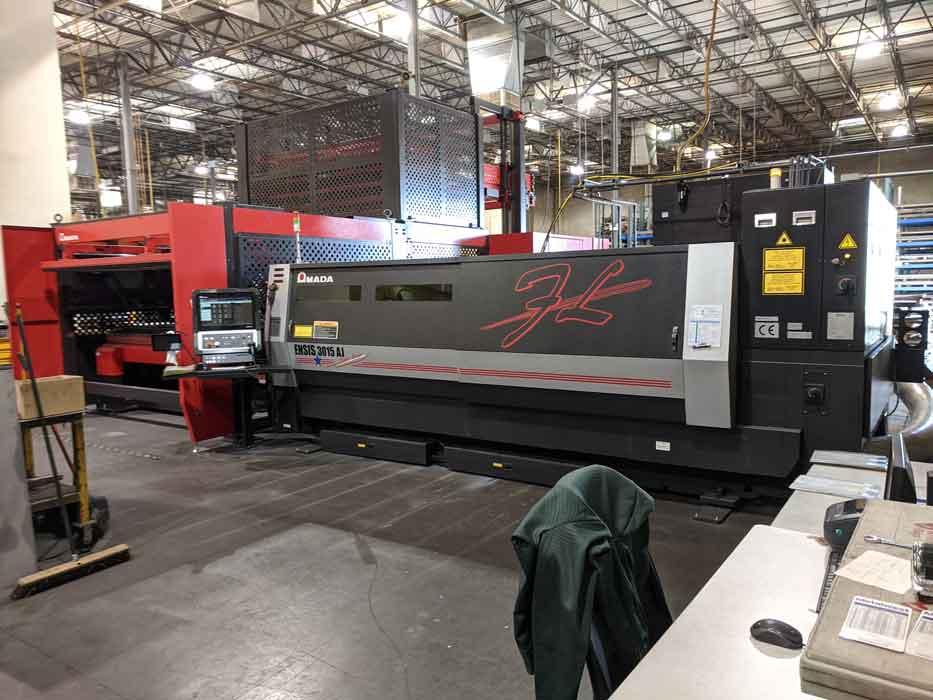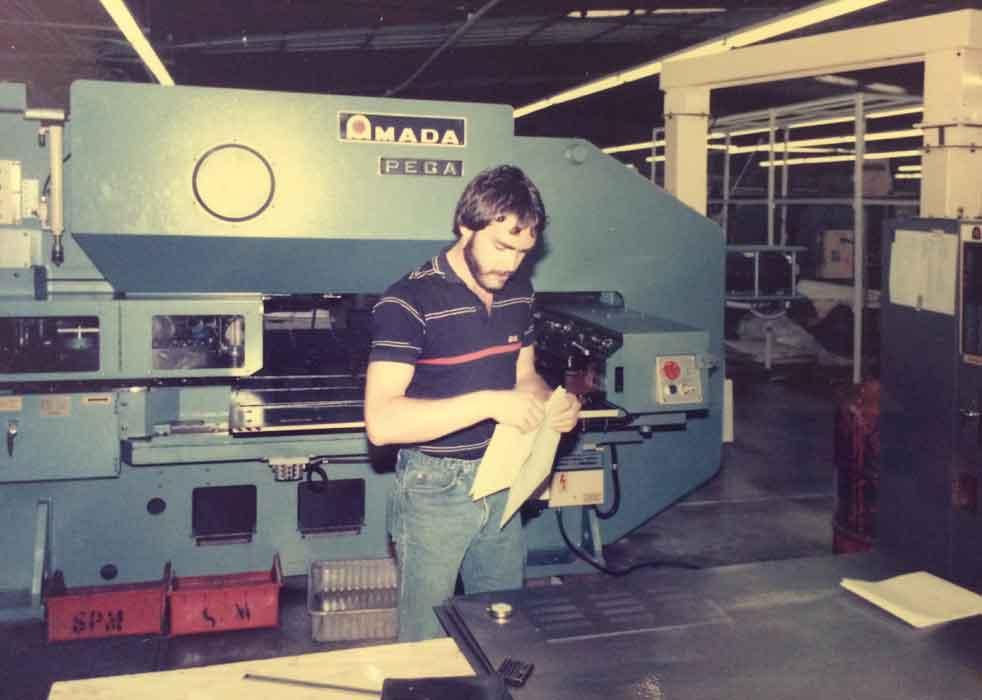Senior Editor
- FMA
- The Fabricator
- FABTECH
- Canadian Metalworking
Categories
- Additive Manufacturing
- Aluminum Welding
- Arc Welding
- Assembly and Joining
- Automation and Robotics
- Bending and Forming
- Consumables
- Cutting and Weld Prep
- Electric Vehicles
- En Español
- Finishing
- Hydroforming
- Laser Cutting
- Laser Welding
- Machining
- Manufacturing Software
- Materials Handling
- Metals/Materials
- Oxyfuel Cutting
- Plasma Cutting
- Power Tools
- Punching and Other Holemaking
- Roll Forming
- Safety
- Sawing
- Shearing
- Shop Management
- Testing and Measuring
- Tube and Pipe Fabrication
- Tube and Pipe Production
- Waterjet Cutting
Industry Directory
Webcasts
Podcasts
FAB 40
Advertise
Subscribe
Account Login
Search
Cutting's Current State: The evolution of blank-to-bend strategies
How the early days of the turret punch press took shape in Texas at Special Products & Mfg.
- By Tim Heston
- April 6, 2020
- Article
- Laser Cutting

Before SPM bought its first fiber laser, it jumped into punch/laser combination cutting. It now has two combos, and both are connected to automation. Images provided by Special Products & Mfg.
Editor's note: This is the last part of our four-part Cutting's Current State series to commemorate our 50th anniversary. Check out Part I, Part II, and Part III.
The cutting operation is the precision sheet metal shop’s heartbeat, and it’s been that way for as long as The FABRICATOR has been around. The magazine’s publisher, the Fabricators & Manufacturers Association International, was founded in 1970 in part to help machine manufacturers and their customers make the most out of the emerging “flex tooling” technology. In a sense, the industry today is a testament to the astounding capabilities of sheet metal manufacturing tools—punches, forming tools, thermal cutting heads—not dedicated to a single product.
As evident by recent machine investments and the leaps of innovation seen at recent FABTECH shows, metal fabrication’s heart has never been healthier. Now the arteries downstream need clearing, and Rockwall, Texas-based Special Products & Mfg. (SPM) has been doing just that. It has three Amada press brakes that change tools automatically, and earlier this year it installed a fourth press brake with automated tool change. The latest one is robotized, with one robot dedicated to forming and another dedicated to changing out tools.
All this bending power is handling blanks from a cutting department that, personnel- and machine-wise, is smaller than it was 20 years ago. Industrywide, smaller cutting departments are producing more parts than ever, and SPM’s is a prime example.
One Replaces Three
SPM’s customer base has changed over the years, but the vast majority demand sheet metal products 10 ga. and thinner. The shop can cut thicker material—it’s a job shop, after all—but gauge material remains its bread and butter. Considering the fiber laser’s astonishing speed on thin stock, it’s not entirely unexpected that one 2-kW fiber laser (an Amada) produces more than the three automated CO2 lasers it replaced.
Cutting technology at SPM advanced gradually since 1995, when it installed its first CO2 laser cutting machine. “It had all of 1,000 watts of cutting power and absolutely no automation to speak of,” mused James Morris, chief technology officer. “It was our first step into laser cutting when, just a decade before, it seemed to take people with 10 doctorate degrees in white lab coats to run a laser.”
SPM ran that machine five years before installing its second CO2 laser. “That one was a highly powerful 1,500-W machine,” Morris mused again.
At that point the company connected both machines to a central tower system. Then eight years after that, in 2008, it added another CO2 laser, a 4 kW, to its tower system.
Nine years later came the 2-kW fiber laser with a tower and a dramatic increase in throughput. SPM followed this investment with a stand-alone 3-kW fiber laser. “We use the 3-kW laser for quick-turn work, and it allows us to cut thicker material when we need to,” Morris said. “Meanwhile, the 2-kW fiber laser with the tower carries the brunt of the production laser cutting work.”
So now it’s a new era at SPM, right? The shop’s operating like a modern jet, with just one extraordinarily powerful and reliable engine (fiber laser) on each wing. Those two “engines” support ever more productive downstream operations, complete with a collection of ATC brakes.

SPM’s 2-kW fiber laser has extensive automation, but its 3-kW fiber doesn’t. Why? It has to do with the operation’s part mix.
Is this a harbinger? Could the industry see a day when just one or a handful of insanely productive lasers feed an army of ATC press brakes and manual and robotic welding cells? Not necessarily. SPM’s punch presses continue to punch away—proof that the laser is just one piece of a far more complicated blanking puzzle.
Punching’s Place
In sheet metal design, simplest is often best, and simple shapes can be seen being punched on four stand-alone turrets that are more than 20 years old—and SPM has been punching for much longer. It installed its first turret punch press in 1980, an Amada Pega, the first of its kind in the state of Texas. By 2008 SPM was a punch press enthusiast’s paradise, with five turret punches and three punch/shear combination machines.
“We had a job for one of our customers that never exceeded 50 parts, and they were extremely intricate, all out of 0.090-in. aluminum,” Morris recalled. “We were running these on punches, and even with 58 stations in the turret, sometimes there just weren’t enough stations because these parts were so intricate.
“So we purchased our first punch/laser combo with the intent of putting a semipermanent tool load in the turret and running that family of parts, using a laser anywhere we didn’t have a suitable punch tool. We got the machine installed, and about three months later, the customer pulled the entire product line and sent it to China.”
Morris chuckled. “That’s international trade for you.”
Regardless, SPM was force-fitting some of its products onto blanking equipment that really wasn’t optimal for the products. “For instance, when we invested in our three punch/shear combos, we were doing a lot of rectangular products,” Morris said. “That’s where those machines really shine.” Punch tools processed the cutouts, the shears cut the perimeter, and the machine sorted the parts and scrap—no skeletons, no shaking and breaking. And when the part mix was all rectangles, material yields were sky-high.
Over time, though, the part mix changed, and straight edges gave way to contours. “We really were force-fitting those parts onto those punch/shear combos,” Morris said, “so when capacity opened up on the punch/laser system, we moved that work over.”
When fiber laser sales really began to pick up steam about a dozen years ago, it looked as if everything was about to change. Some expert presentations, as seen at FABTECH and other industry events, showed the potential of an amazing laser cutting future. Perhaps we’d see just a handful of incredibly powerful, fully automated lasers feeding an enormous number of downstream operations. But it turned out to be not that simple.
A fabricator’s cutting strategy changes with its customer base. SPM’s mix of cutting technology serves not only its customers but also its employees, providing a good training and career path for its punch and laser specialists. A new punching machine operator usually starts in the sharpening area. “We’ve learned that not everyone does the tooling process [like inspection and regrinding] the same way,” said Jason Grand-Lienard, production supervisor. “So when new folks are hired on, we want them to get comfortable with the way we do tooling here at SPM. They need to understand our strategy completely before placing tools in a turret.
“After a few months of training on the tooling side, we put them on a punch, and they shadow the operator for about a month or two or until they’re deemed capable of running the machine on their own.”
The way SPM staffs its turret punches hints at what kind of products run through the machines. Each punch operator has a fork truck license. So if they have time, and the cutting department’s dedicated material handler isn’t available, a punch operator can offload material. This might create a little more punch machine idle time, but the stand-alone punches aren’t the company’s production machines. They instead help SPM respond quickly to low-volume, simple-geometry work. The goal is to get those low-volume orders downstream as quickly as possible.
“If we’re running little rectangular brackets with, say, two holes in them, and we only need 200, we can set up and complete the job on the stand-alone turret before we can have the material loaded onto the tower for the combo,” Morris said. “The stand-alone turrets still play an important role in our operation.”
Of course, the stand-alone turrets still can produce higher volumes of certain parts. “Three of our turrets have single-pallet loaders,” Morris said. “So we can throw a few hundred sheets of, say, 16-ga. on there and let it run for a while. They’re still very productive.”
Combo Strategies
Once operators get their feet wet on punching, they climb the ladder and are cross-trained on the punch/laser combination machines. Each with its own material handling tower, the machines churn away on complex jobs. Strategic nesting, cut sequencing, and microtabbing are especially critical. As Morris explained, an automated, suction-based parts picker removes about 70% of the completed parts from the machine.
The punch cuts parts as the sheet is clamped and moved in X and Y, like a traditional punch press. Moving along its own axis of motion, the laser makes the final cuts of a part as the sheet sits motionless—just as it would on a flying-optics laser cutting machine—breaking the part loose in a position where the parts picker can retrieve and stack it.
It’s a departure from the conventional shake-and-break operation. And again, SPM does leave about 30% of its parts tabbed in the skeleton, to be sent back to the tower for later retrieval by the shake-and-break team. Parts picking is great, but not at the risk of unstable parts that could tip up and crash a cutting head.
Observing the parts picker in action, one might think the automation to be overly complicated and tedious. Why go through the effort to orient parts and sequence the operation for the parts picker?
The reason is simple. As Morris explained, the picker keeps parts on the move. Measure the time between the first cut on the punch/laser combo and the first bend on the press brake, and the automation usually comes out ahead. Perhaps most important, the automation is predictable and consistent. “You might think shaking and breaking is faster for the first 30 minutes you do it,” Morris said. “Then you get tired.”
Being automated, of course, the machine can keep running unattended. “We run the punch/lasers pretty much nonstop over the weekend,” Morris said. “Someone comes in to move finished product and load fresh material [into the tower], but that’s about it.”
Laser Cutting Strategy
A similar, keep-the-parts-moving strategy applies to SPM’s two fiber lasers, one a 2-kW and another a 3-kW, the latter of which lacks automation. Why not automate the 3-kW laser? It’s more powerful than the automated 2-kW fiber laser, so how can operators possibly keep up?
It again goes back to SPM’s customer mix. The fabricator tends to cut thicker stock (up to about 3/8 in.) as part of its “long tail” of lower-volume jobs, often to meet the cutting needs of larger customers who usually order thinner parts. And if working with thicker stock—especially if it involves a nest of numerous small parts—operators have no trouble manually denesting the machine before the next cutting cycle finishes.
The 2-kW laser has a tower system and, hence, is dedicated to production runs of thin sheet.
“When we’re really busy, that single automated fiber laser will produce between 90 and 100 hours a week of cutting by itself,” Morris said. “Years ago the three CO2 lasers that were part of the FMS [flexible manufacturing system] produced about 60 hours of cutting a week—not each machine, but for the entire group.”
Blank to Bend
One operator mans both fiber lasers. Each of the company’s three punch/laser combos has a dedicated operator, as do the four stand-alone punches. That’s a skeleton crew producing more parts than ever, hence the need for new strategies in bending.
In many ways the fabricators covered in this series have very different blanking strategies. One operation (Cupples’ J&J Co. Inc.) has 12- and 15-kW lasers that cut extraordinarily quickly through thick stock; nesting and staffing are optimized for efficient unloading. Other operations have fully automated fiber lasers that concentrate on thin stock, cutting through the night and weekend. Punch/laser systems leave pieces stacked and ready for downstream processing.
The fiber laser continues to evolve, with some machines refining the beam parameters to widen the kerf to make the operation “part picking-friendly,” even for the most intricate blank contours. The blanking evolution continues, and shops have more options to choose from than ever.
The operations at SPM and other shops in this series show just how individualized modern blank-to-bend strategies are. It really does depend on the fab shop. You still hear talk about cutting certain sheet and (especially) plate at so many inches per minute, but usually in the context of the blank-to-bend cycle—or, more specifically, the first cut to the final bend. The idiosyncrasies of the cut-to-bend cycle change with the job, but a common thread runs throughout: A cut part isn’t truly “cut” unless a downstream operation can do something with it.
About the Author

Tim Heston
2135 Point Blvd
Elgin, IL 60123
815-381-1314
Tim Heston, The Fabricator's senior editor, has covered the metal fabrication industry since 1998, starting his career at the American Welding Society's Welding Journal. Since then he has covered the full range of metal fabrication processes, from stamping, bending, and cutting to grinding and polishing. He joined The Fabricator's staff in October 2007.
Related Companies
subscribe now

The Fabricator is North America's leading magazine for the metal forming and fabricating industry. The magazine delivers the news, technical articles, and case histories that enable fabricators to do their jobs more efficiently. The Fabricator has served the industry since 1970.
start your free subscription- Stay connected from anywhere

Easily access valuable industry resources now with full access to the digital edition of The Fabricator.

Easily access valuable industry resources now with full access to the digital edition of The Welder.

Easily access valuable industry resources now with full access to the digital edition of The Tube and Pipe Journal.
- Podcasting
- Podcast:
- The Fabricator Podcast
- Published:
- 04/16/2024
- Running Time:
- 63:29
In this episode of The Fabricator Podcast, Caleb Chamberlain, co-founder and CEO of OSH Cut, discusses his company’s...
- Trending Articles
How to set a press brake backgauge manually

Capturing, recording equipment inspection data for FMEA

Tips for creating sheet metal tubes with perforations

Are two heads better than one in fiber laser cutting?

Hypertherm Associates implements Rapyuta Robotics AMRs in warehouse

- Industry Events
16th Annual Safety Conference
- April 30 - May 1, 2024
- Elgin,
Pipe and Tube Conference
- May 21 - 22, 2024
- Omaha, NE
World-Class Roll Forming Workshop
- June 5 - 6, 2024
- Louisville, KY
Advanced Laser Application Workshop
- June 25 - 27, 2024
- Novi, MI



























